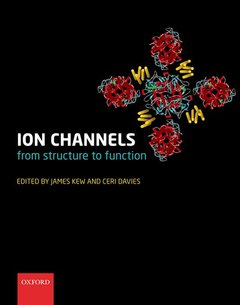Ion Channels From Structure to Function
Langue : Anglais
Coordonnateurs : Kew James, Davies Ceri

Ion channels are intimately involved in the everyday physiological functions that enable us to live a full and varied life. When disease strikes, malfunction of ion channels or their dependent processes is often involved, either as the cause or effect of the illness. Thus, billions of dollars have been, and still are being, invested in research to understand the physiological and pathophysiological functions of ion channels in an attempt to develop novel therapeutic treatments for a wide range of diseases. This book provides a comprehensive overview of ion channel structure and function. It comprises two major parts: Part one - an introductory overview of the ion channel superfamily and the generic aspects of ion channel function. This part also reviews the methodologies by which ion channel function can be studied from the perspective of performing detailed biophysical characterisation through to the deployment of high throughput approaches for identifying novel ion channel ligands. Part two of the book provides an in-depth review of the individual ion channel subfamilies and, as such, is subdivided into four broad sections: Voltage-Gated Ion Channels, Extracellular Ligand-Gated Ion Channels, Intracellular Ligand-Gated Ion Channels, and Polymodal-Gated Ion Channels, with each chapter therein focused on specific family members. These chapters have been written by world leading experts and provide a detailed overview of the structure, biophysics, localization, pharmacology, physiology, and disease relevance of each particular ion channel subfamily. Reviewing both the basic principles of ion channel function and providing a detailed up-to-date review of the physiological and pharmacological aspects of individual ion channel sub-families, this book constitutes both an excellent introduction to the field for non-specialists as well as a highly valuable reference text for experienced researchers already working in the ion channel area.
Introduction. 1. Introduction to Ion Channel Structure and Function. Voltage Gated Ion Channels. 2.1. Voltage-Gated K+ channels. 2.2. Kv1-Kv6 \ Kv8-Kv9 family. 2.3. Kv7 family. 2.4. Kv10-Kv12 families. 2.5. K2P families. 2.6. Voltage-Gated Ca2+ Channels. 2.7. Voltage-Gated Na+ Channels. 2.8. Voltage-Gated Chloride Channels. 2.9. Hyperpolarization-Activated Channels. Extracellular Ligand-Gated Ion Channels. 3.1. Cys Loop Receptors. 3.2. Nicotinic Acetylcholine Receptors. 3.3. 5-HT3 receptors. 3.4. Glycine Receptors. 3.5. GABAA receptors. 3.6. Glutamate Receptors. 3.7. AMPA Receptors. 3.8. Kainate Receptors. 3.9. NMDA Receptors. 3.10. ATP Receptors. 3.11. P2X Receptors. 3.12. Others. 3.13. Acid Sensing Ion Channels (ASICs). 3.14. Epithelial Sodium Channels. Intracellular Ligand-Gated Ion Channels. 4.1. Chloride Channels Activated by Intracellular Ligands. 4.2. Cyclic Nucleotide-Gated Cation Channels. 4.3. KCa1- KCa5 Families. 4.4. KIR family. 4.5. KIR1,2,4,5,7 families. 4.6. KIR3 family. 4.7. KIR6 (KATP) family. 4.8. Ryanodine Receptors. 4.9. IP3 receptor. Polymodal Gated Ion Channels. 5.1. Transient Receptor Potential Channels. 5.2. Connexins - Gap Junctions.
James Kew received a degree in Biological Sciences from Exeter University in 1991 and a Ph.D. from Cambridge University in 1995. He joined F.Hoffmann-La Roche in Basel in 1995, first as a postdoctoral scientist and subsequently as head of an electrophysiology and cell biology laboratory. During this period his work focussed on the pharmacology, physiology/pathophysiology and therapeutic potential of both ionotropic and metabotropic glutamate receptors and their ligands. He joined GlaxoSmithKline in 1995 as Head of Electrophysiology in the Psychiatry CEDD before moving to head the newly formed Psychiatry Discovery Technology Group in October 2006. Since October 2008 he has led the Molecular and Cellular Biology group within the Schizophrenia and Cognitive Disorders Discovery Performance Unit in the Neurosciences CEDD. Ceri Davies received BSc (Hons) and Ph.D. degrees in Pharmacology from Bristol University in 1988 and 1991. He held a Lectureship in Neuropharmacology at the University of Edinburgh until 1998 when he moved into the pharmaceutical industry running an electrophysiology team at Organon laboratories near Glasgow. During this appointment his work focussed on developing novel approaches to treat psychiatric disorders. He joined GlaxoSmithKline a year later as Head of Electrophysiology in the Neurology and Gastrointestinal Centre for Excellence in Drug Discovery (CEDD) before moving to head up the Neuropharmacology and Physiology department in the Psychiatry CEDD in 2003. Since May 2008 he has led the Synaptic Plasticity and Neural Networks Discovery Performance Unit within the newly formed Neurosciences CEDD.
Date de parution : 09-2009
Ouvrage de 576 p.
22.7x28.4 cm
© 2024 LAVOISIER S.A.S.



